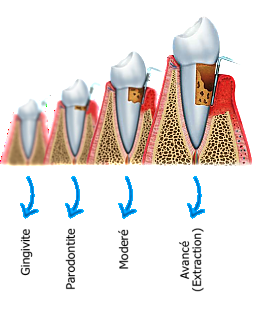The word “periodontal” translates to “around the tooth”. Periodontal diseases (pyorrhea) are bacterial infections of the gums that destroy the supporting ligaments and bone that hold your teeth place. Periodontal diseases can affect one or many teeth. The main cause of this disease is the bacteria filled sticky substance called plaque. If the plaque is not removed, it can form into a substance called tartar or calculus. Tartar is so hard it can only be removed by an oral health professional, such as a dentist or dental hygienist. The bacteria in plaque and tartar infect the gums, and cause redness and inflammation (irritation). This inflammation causes destruction of the tissues that support the teeth, including the bone. When this happens, the gums separate from the teeth, forming pockets that fill with even more plaque leading to further bone loss and eventually tooth loss.
Periodontal diseases are characterized by bad breath, bleeding, swollen or painful gums, and looseness or drifting of teeth.
The goal of all periodontal therapy is the elimination of active infection and to provide healthy gums that the patient can keep clean with proper brushing and flossing techniques. Shallower pockets are easier for the patient to clean than deeper pockets, and stable teeth are more predictable to maintain than mobile teeth. A specific treatment plan will be selected for each individual patient.
Early diagnosis and intervention is imperative for predictable treatment of periodontal disease. Gingivitis (gum infection without bone loss) can often be corrected non-surgically through scaling, root planing and proper patient brushing and flossing. When bone loss has occurred, some reshaping of the gum and/or bone may be necessary. Finally, when more severe bone loss has taken place, various biomaterials are often utilized to rebuild the resorbed bone thus eliminating the pockets and stabilizing the teeth.

